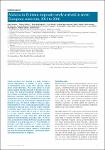Malaria in Eritrean migrants newly arrived in seven European countries, 2011 to 2016
Sondén, Klara
Rolling, Thierry
Wångdahl, Andreas
Ydring, Elsie
Vygen-Bonnet, Sabine
Kobbe, Robert
Douhan, Johan
Hammar, Ulf
Duijster, Janneke
de Gier, Brechje
Freedman, Joanne
Gysin, Nicole
Stark, Klaus
Stevens, Flora
Skafte Vestergaard, Lasse
Tegnell, Anders
Färnert, Anna
Global migration has resulted in a large number of asylum applications in Europe. In 2014, clusters of Plasmodium vivax cases were reported among newly arrived Eritreans. This study aimed to assess malaria among Eritrean migrants in Europe from 2011 to 2016. We reviewed European migration numbers and malaria surveillance data for seven countries (Denmark, Germany, Netherlands, Norway, Sweden, Switzerland and the United Kingdom) which received 44,050 (94.3%) of 46,730 Eritreans seeking asylum in Europe in 2014. The overall number of malaria cases, predominantly P. vivax, increased significantly in 2014 compared to previous years, with the largest increases in Germany (44 P. vivax cases in 2013 vs 294 in 2014, p < 0.001) and Sweden (18 in 2013 vs 205 in 2014, p < 0.001). Overall, malaria incidence in Eritreans increased from 1–5 to 25 cases per 1,000, and was highest in male teenagers (50 cases/1,000). In conclusion, an exceptional increase of malaria cases occurred in Europe in 2014 and 2015, due to rising numbers of Eritreans with high incidence of P. vivax arriving in Europe. Our results demonstrate potential for rapid changes in imported malaria patterns, highlighting the need for improved awareness, surveillance efforts and timely healthcare in migrants.
Files in this item

